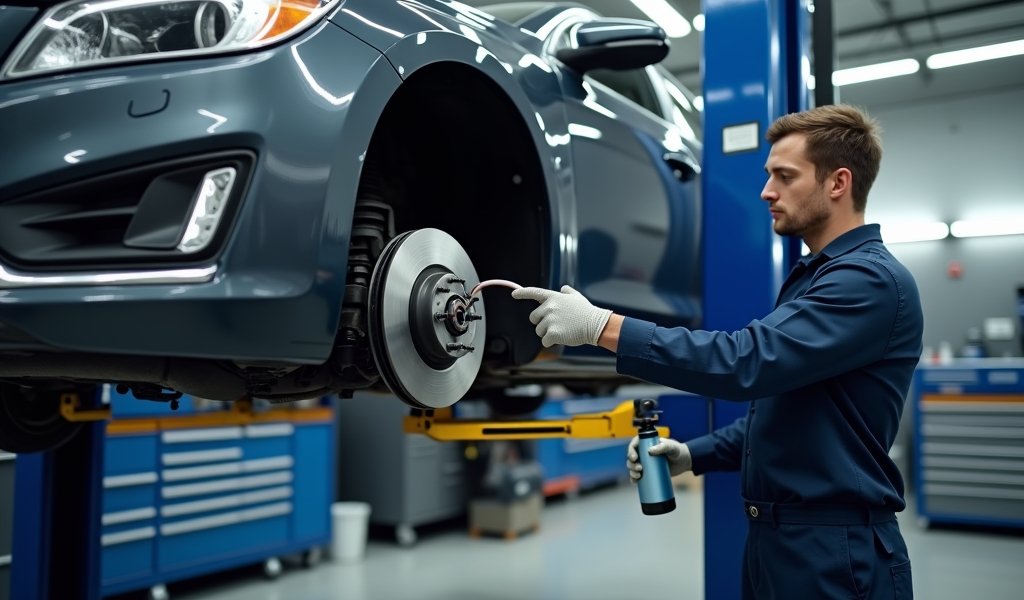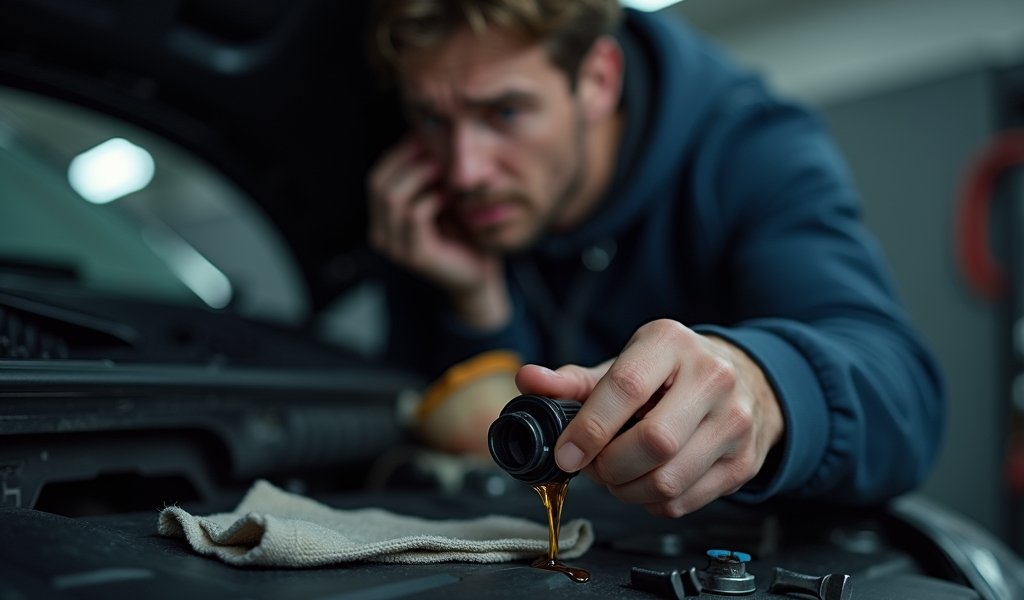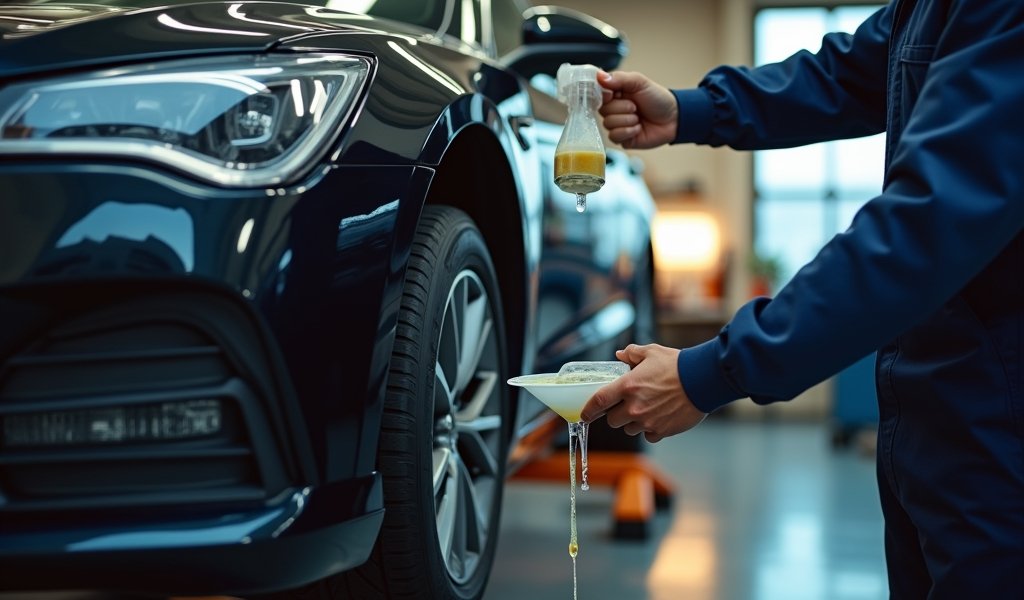Overview
This article explains that brake fluid changes are critical for safety yet often overpriced at $80-$200+ by professionals, while DIY methods cost only $40-$48 for the first change and $17-$25 for subsequent ones, potentially saving drivers $400-$790 over ten years. It provides step-by-step instructions for DIY brake fluid changes, discusses when professional service makes more sense (for complex systems or warranty considerations), and emphasizes that regular changes every 2-3 years prevent moisture contamination that can cause brake failure and expensive repairs.
Table of Contents
- Why Brake Fluid Changes Matter
- Professional Service Costs Breakdown
- DIY Approach: Materials Needed
- Step-by-Step DIY Process Overview
- Cost Comparison: DIY vs. Professional
- Money-Saving Tips Beyond DIY
- When Professional Service Makes More Sense
- Conclusion
- Frequently Asked Questions
Maintaining your vehicle’s brake system isn’t just about safety—it’s about smart ownership. After 25 years turning wrenches, I’ve seen countless folks shocked by the price tag on a simple brake fluid change. That $80-$200+ quote from the dealership? It doesn’t have to be that way. With some basic knowledge and a few tools, you can save over $150 while keeping your braking system in top shape.
Brake fluid changes often fly under the radar of regular maintenance, but they’re absolutely critical for your safety and your vehicle’s longevity. At the end of this guide, you’ll understand not just why this service matters, but exactly how to do it yourself—or get it done professionally without breaking the bank.
Let’s dive into what every driver should know about brake fluid change costs and how to keep both your vehicle and wallet happy.
Why Brake Fluid Changes Matter
Think of brake fluid as the lifeblood of your stopping power. This specialized hydraulic fluid transfers force from your foot on the pedal to the components that physically slow your wheels. Unlike other fluids, brake fluid works under extreme pressure and temperature conditions—sometimes exceeding 400°F during heavy braking.
Here’s what makes regular changes so important: brake fluid is hygroscopic, meaning it absorbs moisture from the surrounding air. Even through sealed systems, water content can reach 3% after just two years. This moisture contamination lowers the fluid’s boiling point significantly, potentially creating vapor bubbles in your brake lines during hard stops.
When moisture contamination reaches critical levels, you’ll notice:
- Spongier brake pedal feel
- Longer stopping distances (particularly dangerous in emergencies)
- Brake fade during repeated or heavy braking
- Internal corrosion of metal components
According to the National Highway Traffic Safety Administration, most manufacturers recommend changing brake fluid every 2-3 years regardless of mileage. However, I’ve found through testing that vehicles in humid climates often need service sooner. Fresh fluid appears clear to amber, while contaminated fluid looks dark brown or black—a visual indicator even novices can spot.
Skipping this maintenance doesn’t just affect performance—it leads to expensive repairs down the road. Corroded calipers, damaged master cylinders, and compromised ABS modules can turn a $40 DIY fluid change into thousands in repair bills.

Professional Service Costs Breakdown
When you take your vehicle to a pro for a brake fluid change, you’re paying for more than just the liquid. The typical price ranges I see daily across the industry break down like this:
- Dealership service: $150-$250 (higher for luxury or European vehicles)
- Independent repair shops: $80-$150
- Quick lube chains: $70-$120 (though I often recommend against these for brake work)
What exactly are you getting for those dollars? Let’s break it down:
- Labor costs ($60-120): Technician time typically billed at 0.5-1.0 hours
- Materials ($15-30): Quality brake fluid meeting your vehicle’s specifications
- Equipment use ($5-15): Specialized bleeding tools and diagnostic equipment
- Expertise: Problem identification and proper bleeding techniques
- Disposal fees: Environmentally appropriate handling of old fluid
- Warranty: Guarantee on the work performed
The average cost of car service for brake fluid changes has increased about 15% over the past five years, outpacing inflation. This trend makes the DIY approach increasingly attractive for budget-conscious drivers.
While dealers often charge premium rates, they do have manufacturer-specific training and equipment. However, most independent shops can perform the service just as effectively at significantly lower rates. The markup on professional service creates the perfect opportunity for substantial DIY savings.
DIY Approach: Materials Needed
Getting your hands dirty with a brake fluid change isn’t complicated, but you’ll need the right supplies. Here’s my professional shopping list for a proper DIY job:
- Brake fluid ($8-25): Choose the exact type specified by your manufacturer (DOT 3, DOT 4, DOT 5.1). Never substitute! The difference between types involves boiling points and chemical compositions.
- Brake bleeding kit ($10-20): A basic one-person kit with catch bottle and check valve works for most vehicles.
- Wrench for bleeder valves ($5-15): Typically 8mm, 10mm, or 11mm – check your specific model.
- Fluid catch container ($3): Any small, clean container works.
- Nitrile gloves ($5): Brake fluid destroys paint and irritates skin.
- Clean rags ($3): Microfiber works best for cleanup.
- Optional but recommended: Brake fluid tester ($5-15): Tests moisture content accurately.
The type of brake fluid you choose matters tremendously. Most modern vehicles use either DOT 3 (boiling point 401°F) or DOT 4 (boiling point 446°F). Performance vehicles might require DOT 5.1 (boiling point 500°F+). Using the wrong type can cause seal damage or system failure.
I strongly recommend purchasing a quality brand like Valvoline, Castrol, or Motul. The few dollars difference between economy and premium fluids is negligible compared to the protection you’re getting for your braking system. Fresh, high-quality brake fluid might just be the difference between stopping safely and not stopping at all in an emergency situation.
All these supplies are readily available at any auto parts store, and many of the tools will serve you for multiple fluid changes, spreading their cost across years of maintenance savings.
Step-by-Step DIY Process Overview
Before diving into this process, remember that safety comes first. I’ve seen too many DIY disasters from rushed jobs. Work in a well-ventilated area away from open flames, wear protective gear, and never let brake fluid contact painted surfaces.
Here’s my tried-and-true process broken down into manageable steps:
Preparation Phase
- Ensure the vehicle is on level ground with engine off and cool
- Gather all materials and tools beforehand
- Locate your brake fluid reservoir (typically on the driver’s side of the engine compartment, near the firewall)
- Check your service manual for any vehicle-specific procedures
Fluid Replacement Process
- Remove the reservoir cap and use a clean turkey baster or syringe to extract as much old fluid as possible
- Refill the reservoir with fresh fluid to the “MAX” line (but don’t overfill)
- Starting with the wheel furthest from the master cylinder (usually right rear), locate the bleeder valve on the brake caliper or wheel cylinder
- Place a wrench on the bleeder valve and attach your bleeding tube, with the other end in your catch container
- Have a helper slowly press the brake pedal to the floor
- While the pedal is down, open the bleeder valve about a quarter turn
- Close the valve before your helper releases the pedal
- Repeat steps 5-7 until the fluid coming out is clear and free of air bubbles
- Move to the next wheel (typically left rear, then right front, then left front) and repeat the process
- Check the reservoir frequently and refill as needed—never let it run empty!
- Once complete, ensure the reservoir is filled to the proper level and securely replace the cap
For beginners, expect to spend 1-2 hours on your first attempt. With experience, you can complete the entire process in 30-45 minutes. If you’re working alone, a one-person bleeder kit with check valves eliminates the need for a helper.
A few pro tips I’ve learned over decades of wrenching:
- Keep a spray bottle with water and mild soap handy to immediately clean any spills
- Never reuse old brake fluid, even if it looks clean
- After completion, press the brake pedal several times before starting the engine to rebuild pressure
- Drive cautiously for the first few miles to ensure proper brake operation
The complete car service guide should include regular brake fluid changes as part of your maintenance routine. This process gets easier with practice, and the confidence of knowing your braking system is in top condition is invaluable.

Cost Comparison: DIY vs. Professional
Let’s get down to dollars and cents—the real reason you’re considering the DIY route. I’ve tracked costs across hundreds of vehicles, and the savings are substantial:
Professional Service Average Costs:
- Dealership: $175
- Independent shop: $120
DIY Costs Breakdown:
- Quality brake fluid (1 quart): $12-20
- Basic bleeding kit: $15 (one-time investment)
- Wrench (if needed): $8 (one-time investment)
- Disposables (gloves, rags): $5
Total DIY cost for first change: $40-48
Total DIY cost for subsequent changes: $17-25 (since you’ll already have the tools)
That translates to savings of $80-135 on your first DIY brake fluid change, and $95-158 on each subsequent service. For a vehicle kept 10 years with fluid changes every 2 years, you’re looking at total savings of $400-790!
Beyond the direct cost comparison, consider these additional financial benefits:
- No appointment scheduling or waiting room time (value your time at $25/hour?)
- No transportation costs to and from the shop
- No upselling pressure for services you might not need
- Developing mechanical skills that save money on other repairs
The return on investment for your time becomes even more apparent when you consider that the same tools can be used for multiple vehicles in your household. For a family with 2-3 vehicles, the DIY approach can save over $1,500 in maintenance costs over a decade.
Money-Saving Tips Beyond DIY
Not everyone has the time, space, or inclination to tackle brake work themselves—and that’s perfectly fine. If you prefer professional service, I’ve got insider tips to keep costs reasonable without compromising safety:
Finding Better Professional Deals
- Ask about price-matching policies at independent shops
- Schedule during seasonal promotions (many shops run brake specials in spring and fall)
- Look for “new customer” discounts at reputable shops
- Request inspection-only services first to confirm the work is necessary
Bundle Services Strategically
Combining your brake fluid change with other maintenance often unlocks package pricing. Services that pair well include:
- Brake inspections (often discounted or free when combined)
- Tire rotations (technicians are already removing wheels)
- Overall vehicle inspections (many shops offer discounted “bundled” safety checks)
Many facilities offer affordable auto service packages that include brake fluid changes at significant discounts when combined with other maintenance. This approach often saves 15-25% compared to ordering services individually.
Leverage Loyalty Programs
Many national chains and even local shops now offer point-based loyalty programs. These typically provide:
- Discounted or free services after reaching point thresholds
- Member-only promotions and early access to sales
- Birthday or anniversary discounts
For example, Firestone’s rewards program offers points for every dollar spent, which can be redeemed for future services—effectively creating a 5-10% discount on all maintenance including brake fluid changes.
While seeking savings, remember that brake maintenance is never the place to cut corners on quality. Premium brake fluid typically costs only $3-5 more than basic options but provides better moisture resistance and higher boiling points—critical factors in brake performance and longevity.
When Professional Service Makes More Sense
As much as I advocate for DIY maintenance, there are legitimate scenarios where professional service is the wiser choice. Recognizing these situations can save you headaches and potentially even money in the long run:
Complex Braking Systems
Modern vehicles increasingly feature sophisticated braking technologies that require specialized equipment. If your vehicle has any of these systems, professional service might be preferable:
- Advanced ABS with integrated stability control
- Electronic parking brakes requiring computer resets
- Active braking assistance systems
- Hybrid or electric vehicle regenerative braking integration
These systems often require scan tools for proper bleeding or calibration—equipment that typically costs hundreds or thousands of dollars.
Warranty Considerations
If your vehicle is under factory warranty or has an extended service plan, DIY brake work could potentially void coverage for related components. Always check your warranty documentation before proceeding. Some manufacturers specifically require documented professional service to maintain warranty coverage.
Time and Expertise Limitations
Be honest about your mechanical aptitude and available time. If any of these apply to you, professional service might be the better value:
- You’ve never performed maintenance beyond basic oil changes
- You lack a suitable workspace with proper lighting and ventilation
- Your schedule doesn’t allow for potential complications or learning curve
- You have physical limitations that make crawling around wheels difficult
Remember that improperly performed brake work can compromise safety. If you’re uncertain about your abilities, the peace of mind from professional service is worth the additional cost.
When Brake Issues Go Beyond Fluid
If you’re experiencing any of these symptoms, a simple fluid change might not address the underlying problem:
- Grinding or squealing noises during braking
- Pulling to one side when braking
- Vibration or pulsation through the brake pedal
- Warning lights on the dashboard
These symptoms warrant comprehensive professional inspection before proceeding with maintenance, as they may indicate more serious issues requiring immediate attention.
Conclusion
Fresh brake fluid is your first line of defense against brake failure and costly repairs. Whether you choose the DIY route to save over $150 or opt for professional service with strategic timing, regular brake fluid changes should be non-negotiable in your maintenance schedule.
The knowledge you’ve gained here empowers you to make informed decisions about your vehicle’s care. Even if you never pick up a wrench yourself, understanding what goes into a proper brake fluid change helps ensure you’re getting quality service at a fair price.
Remember that brake maintenance isn’t just about saving money—it’s about protecting yourself, your passengers, and others on the road. That said, the substantial savings from DIY brake fluid changes or smarter professional service scheduling can fund other important maintenance, keeping your vehicle reliable for years to come.
Take action now by checking your maintenance records or inspecting your brake fluid color. If it’s been over two years or the fluid appears dark, it’s time for a change. Your brakes—and potentially your wallet—will thank you.
Frequently Asked Questions
How often should brake fluid be changed?
Most manufacturers recommend changing brake fluid every 2-3 years regardless of mileage. Check your owner’s manual for vehicle-specific intervals.
How can I tell if my brake fluid needs changing?
Fresh brake fluid is clear to amber in color, while fluid needing replacement appears dark brown or black. You can also use an inexpensive brake fluid tester to check moisture content.
Will changing brake fluid improve braking performance?
Yes, fresh brake fluid can restore proper pedal feel and improve stopping power. Contaminated fluid with high moisture content reduces braking effectiveness, particularly during heavy use.
Can I mix different types of brake fluid?
Never mix DOT 3, DOT 4, DOT 5, or DOT 5.1 brake fluids. Always use the exact type specified by your vehicle manufacturer to prevent system damage.
Is it dangerous to drive with old brake fluid?
Old brake fluid with high moisture content can significantly extend stopping distances and cause brake fade during repeated stops. In extreme cases, it could lead to complete brake failure.

